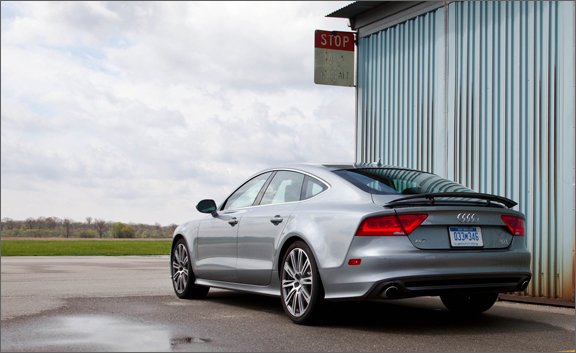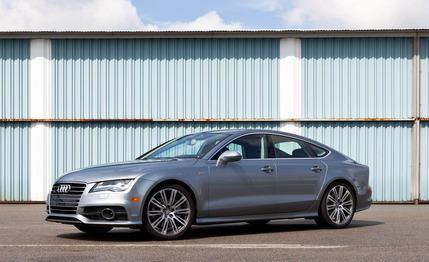 Short Take Road Test
Short Take Road Test
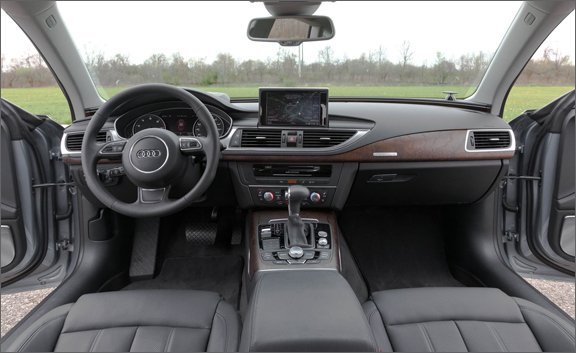
As a stylistic distinction, the term “four-door coupe” has edged perilously close to cliché territory, and we’re grateful that Audi has managed to avoid reveling in it in connection with the new A7, although the company does still use the terminology.
Still, the descriptor—it first appeared in the automotive lexicon nearly eight years ago, when the Mercedes CLS-class concept dazzled sedandom—is more relevant here than in many applications that have come along since, with far less justification. (The Acura ZDX comes to mind.) After all, the A7 has the same styling that distinguished the original CLS—a flowing roofline that swoops down at the rear, disguising the presence of that second set of doors.
In fact, it can be argued that Audi’s take on the FDC genre is the best yet. The design preserves sedan proportions, but as a hatchback/wagon, it doesn’t have to make any compromises to accommodate a formal trunk. At any rate, regardless of whether you go along with this car’s solution, we think this description is beyond dispute: wunderbar.
A6 in Disguise
The foundations for this dramatic sedan are new but will soon see service in support of the next generation of Audi’s A6 sedan, due to go on sale here this fall. But compared with the forthcoming A6, the A7 is longer, lower, and wider—a design mantra that originated in the 1950s and still works today. Overall length is up 2.1 inches to 195.6, the roof—55.9 inches at its apogee—is 1.4 inches lower, and width is up by 1.4 inches—all contributing to the dramatic appearance.
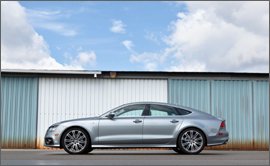
Consistent with other Audis and, indeed, with nearly all German chassis, the A7 architecture seems as stiff as the royal wedding, a fundamental prerequisite of handling certainty. Audi literature makes much of the A7’s aluminum content, which includes 20 percent of the bodywork, and the company claims that its glamorous hatchback weighs some 15 percent less than comparable steel-bodied cars. Maybe so, but “lightweight” is not a term that comes to mind in connection with the A7. Our test car tipped the scales at a hefty 4260 pounds.
Mass vs. Muscle
Mass is always the enemy in vehicle dynamics, but the A7 seems to handle its two tons with better-than-average aplomb. Power, supplied by Audi’s supercharged and intercooled aluminum V-6—3.0 liters, DOHC, direct injection, 310 hp, 325 lb-ft of torque—and delivered to all four wheels via a seamless eight-speed Tiptronic automatic, deals surprisingly well with that A7 heft.
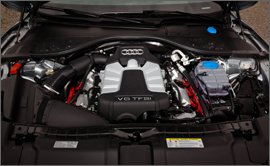
This is basically the same setup offered as the standard powertrain in the Q7 SUV. Compared with that one, the A7’s curb weight makes it a veritable wraith, and the supercharged six propels the new hatchback to 60 mph in 5.4 seconds, to 100 mph in 13.5, and through the quarter-mile in 13.9 at 101 mph.
Acceleration is a little deliberate right out of the blocks—it’s hard to think of the A7 as quick—but comes on strong as momentum gathers. As an index, we recorded passing times—30 to 50 mph and 50 to 70—of 2.8 and 3.6 seconds, respectively. These are very good numbers and an aspect of performance that’s much appreciated when you’re exploiting a marginal passing window on a two-lane highway.
Fuel economy is another area where the A7 does well in spite of its curb weight. The EPA forecasts 18 mpg city/28 highway. We averaged 23 mpg in 873 miles of driving, much of it spirited.
Pretty, Yes, but Does She Dance?
Overassisted at low speeds, the steering comes to life above about 40 mph, delivering a more comprehensive menu of tactile information, as well as more weight. It’s gratifyingly quick at 2.7 turns lock-to-lock, and if the A7’s responses to inputs are a little deliberate, they’re decisive once they happen, and free of quirks.
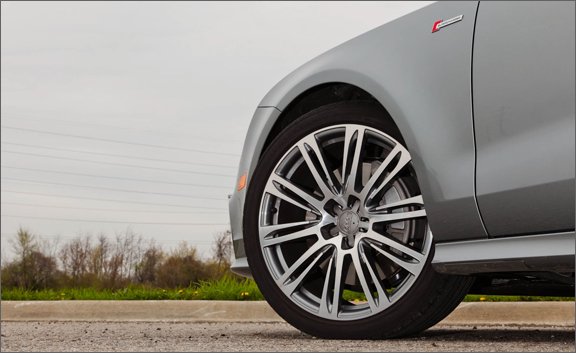
The car’s mass is most apparent in a series of quick directional changes—autocross-level transient response isn’t its strong suit. And as we expected, the combination of curb weight, all-wheel drive, and a forward weight bias adds up to progressive understeer. However, we should mention that Audi has been working hard to correct its chronic nose-heaviness. The A7’s fore-to-aft weight distribution is 54/46 percent, which is approaching the split in some rear-drive cars.
We also were impressed with the A7’s grip, which came in at 0.91 g, delivered by a set of 265/35 Yokohama Advan Sport tires on 20-inch aluminum wheels. That’s not a lot of contact patch for a fast two-ton sedan, but the tires inspired confidence, and the car was at its best on sweeping turns at some eye-widening speeds.
There’s more. Braking performance was consistent and strong—157 feet from 70 mph. And ride quality was simply outstanding, particularly in view of those low-profile Yokes. Even on stretches of rural Michigan pavement resembling asphalt quilts, the A7 was composed and comfortable, damping the hard edges of the nastiest lumps and ironing out the rest.
The Inner Car
In our first-drive report, we noted that the A7 “oozes opulence and simplicity.” The word “stunning” also appeared, and these descriptors seem all the more accurate now that we’ve had more seat time.
The preview catalogued the A7’s garden of electronic systems—the touchpad that can recognize fingertip longhand script (except, perhaps, from doctors); blind-spot monitoring; lane-keeping assist; and adaptive cruise control that’s capable of bringing the car to a complete stop.

We also mentioned the head-up display, and with more experience, we’ve developed some ambivalence about this feature. The speedo repeater is helpful, especially in busy areas where glancing down at the actual gauge can be dicey. But the proximity warning that flashes when the car’s radar decides you’re too close to the car ahead gets to be pretty annoying when you’re dissecting traffic. “Mother, please! I know how to do this! Stow it!”
Speaking of stowing it, there’s a lot of stowage space under that rear hatch—24.5 cubic feet—and, as with all hatches, the cargo well is easier to get at than a conventional trunk’s.
Our test car did indeed ooze opulence. There are superb front seats with lots of adjustability, excellent audio, electronics galore, and rear seats with plenty of leg and headroom, the latter a pleasant surprise given the sloping roofline. We were particularly smitten with the optional, nearly matte oak interior trim. Score another victory for Audi interior design.
The Price of Prestige
Opulence, as you’d expect, doesn’t come cheap. We originally forecast a base price of $55,000. Wrong. Try $60,125.
That includes the Quattro all-wheel-drive system and supercharged V-6—the standard (and only) setup for U.S. versions of the A7—as well as a good array of features: heated leather seats, a power liftgate, a power sunroof, automatic climate control, and xenon headlights, among plenty of other kit.
But there are tempting options packages—Sport (20-inch wheels, firmer suspension); Innovation (LED headlights, adaptive cruise, head-up display, night-vision assist); Prestige (S-line trim, power-adjustable steering column, ventilated front seats, ambient interior lighting); and Bang & Olufsen sound (15 speakers).
Check all those boxes, and you’re looking at $81,530, or exactly the amount on our test car’s Monroney. At that point, you might be tempted to look at some other choices: The A8 starts at $78,925, after all, and the Mercedes CLS550 offers nearly 100 more hp for $72,125. You might also begin wondering what sort of price tag we’ll be seeing when autumn ushers in the new A6.
But A6 or something completely different, it’s clear there are few cars that will be able to upstage the satisfying A7 in sheer curbside wattage.
